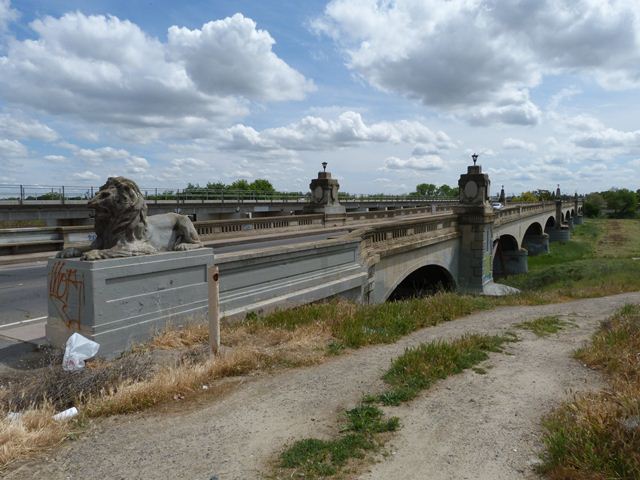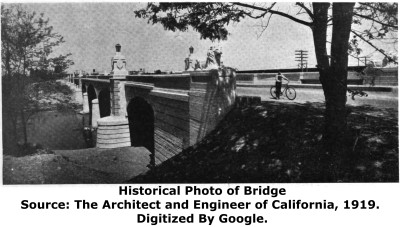We Recommend:
Bach Steel - Experts at historic truss bridge restoration.
Lion Bridge
7th Street Bridge

Primary Photographer(s): Nathan Holth
Bridge Documented: April 6, 2013
Modesto: Stanislaus County, California: United States
1916 By Builder/Contractor: C. E. Cotton and Engineer/Design: Leonard & Day of San Francisco, California
Not Available or Not Applicable
101.0 Feet (30.8 Meters)
1,170.0 Feet (356.6 Meters)
24.3 Feet (7.41 Meters)
14 Main Span(s)
38C0023

View Information About HSR Ratings
Bridge Documentation
This bridge's future is at risk!
View Archived National Bridge Inventory Report - Has Additional Details and Evaluation
View Historic American Engineering Record Documentation For Another Bridge Which Also Discusses John B. Leonard In Detail
View A Book By John B. Leonard and W. P. Day About Concrete Bridges
View Historical Articles That Include Mention of This Historic Bridge
This bridge is a large example, as well as one of the only surviving examples, of a cantilevered concrete arch bridge. Cantilevered concrete arch bridges are exceedingly rare nationwide. Examples in California are usually associated with the firm of Leonard and Day, which is the case with this bridge. Leonard and Day described their bridges as "canticrete" bridges and this term has stuck around in modern discussions about these bridges in California. The term does not appear to have been used by other engineers who built cantilevered concrete arch bridges, like the Belle Isle Bridge in Michigan. The Belle Isle Bridge makes a nice comparison to the 7th Street Bridge because it is also a long, multi-span arch bridge, but was designed by a different engineer, and it has also been preserved, presenting a sharp contrast to the 7th Street Bridge.

Usually, concrete arch bridges do not act like cantilevers. However, some engineers would design arch bridges in a manner that eliminated the need for extensive falsework during construction. This was accomplished by erecting steel trusses in a cantilever form. These trusses would then be encased in concrete. In this sense, the bridge could be thought of as a concrete encased steel cantilever truss bridge. However in the case of the Leonard and Day "canticrete" bridges traditional rebar reinforcing rods were also added alongside the trusses before the concrete was poured to give the bridge additional strength. The historical photo to the right shows a Leonard and Day designed canticrete bridge with the trusses erected, prior to the pouring of concrete.
In addition to its high level of engineering significance, this bridge is also noteworthy for its aesthetic details. The bridge was designed with decorative balustrade railings, and piers that extend above the deck as ornate decorative pillars. The ends of the bridge have benches for people to sit on, and lion sculptures are placed at the ends of the bridge, on top of the railing.
The bridge retains good historic integrity, but the bridge has deteriorated. The beautiful lion sculptures are cracked and crumbling. The northernmost arch span appears to have settled, and in doing so it has clearly revealed its cantilever construction, since the two cantilevered halves of the bridge have separated and one is slightly higher than the other now. A special metal brace has been added under this span. Despite deterioration, this is a bridge that absolutely should not be demolished. Numerous possible preservation scenarios exist. The bridge could be rehabilitated for continued use. For additional traffic capacity, a new one-way bridge could be built next to this bridge, forming a one-way couplet of bridges. Finally, a new two-way bridge could be built next to the historic bridge and the historic bridge could be left in place for non-motorized traffic.
Despite this bridge's high level of historic significance, the county has proposed a project that is being described as a replacement project. This likely means that the bridge is at risk for demolition. However, as a bridge that is eligible for the National Register of Historic Places, this proposed project that involves the use of federal funding will require a Section 106 Review. It is hoped that Section 106 will do what it is supposed to do and reveal a feasible and prudent alternative to demolishing this historic bridge.
The contractor for this bridge was C. E. Cotton. The Historic American Engineering Record provided the following information about a firm Cotton worked for previous to building this bridge:
Bridge builders Cotton Brothers formed their firm in 1891. The partnership consisted of Ernest J. and Charles E. Cotton and J.B. Agassiz. Charles Cotton was a personal friend of John Leonard. Prior to establishment of the firm, Charles worked as Secretary of the California Bridge Company of San Francisco, while Ernest billed himself as a bridge builder- The firm was first advertised in the 1892 Oakland business directory under "Carpenters, Contractors, and Builders." Their offices were initially at 241 Bacon Building, Oakland; later they also opened an office in the Monadnock Building in San Francisco, from which building Leonard also worked. (After Leonard lost his office in the 1906 disaster, he used Cotton Brothers1 office in the Bacon Building as temporary quarters.) Their advertisements in the 1907-08 period billed them as general contractors in steel frame and reinforced concrete construction. Directory advertisements for the firm disappeared after 1908, and Ernest's death in 1913 marked the dissolution of the firm.
It is therefore presumed that after Ernest Cotton died and the firm was shut down, that Charles E. Cotton continued his own contracting work, as evidenced by the Lion Bridge.
![]()
Photo Galleries and Videos: Lion Bridge
Bridge Photo-Documentation
Original / Full Size PhotosA collection of overview and detail photos. This gallery offers photos in the highest available resolution and file size in a touch-friendly popup viewer.
Alternatively, Browse Without Using Viewer
![]()
Bridge Photo-Documentation
Mobile Optimized PhotosA collection of overview and detail photos. This gallery features data-friendly, fast-loading photos in a touch-friendly popup viewer.
Alternatively, Browse Without Using Viewer
![]()
Maps and Links: Lion Bridge
Coordinates (Latitude, Longitude):
Search For Additional Bridge Listings:
Bridgehunter.com: View listed bridges within 0.5 miles (0.8 kilometers) of this bridge.
Bridgehunter.com: View listed bridges within 10 miles (16 kilometers) of this bridge.
Additional Maps:
Google Streetview (If Available)
GeoHack (Additional Links and Coordinates)
Apple Maps (Via DuckDuckGo Search)
Apple Maps (Apple devices only)
Android: Open Location In Your Map or GPS App
Flickr Gallery (Find Nearby Photos)
Wikimedia Commons (Find Nearby Photos)
Directions Via Sygic For Android
Directions Via Sygic For iOS and Android Dolphin Browser
USGS National Map (United States Only)
Historical USGS Topo Maps (United States Only)
Historic Aerials (United States Only)
CalTopo Maps (United States Only)




